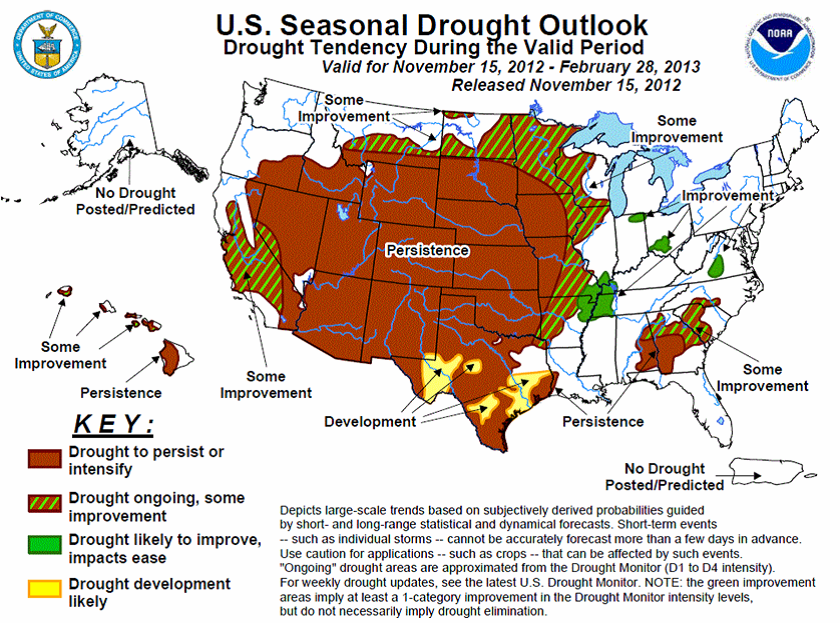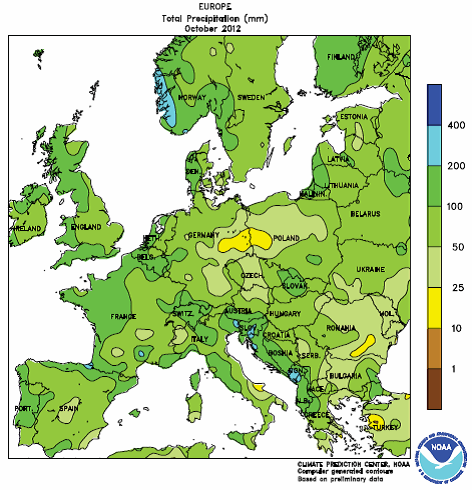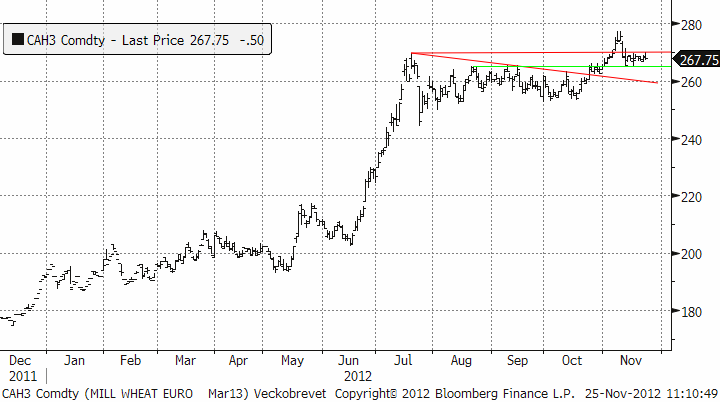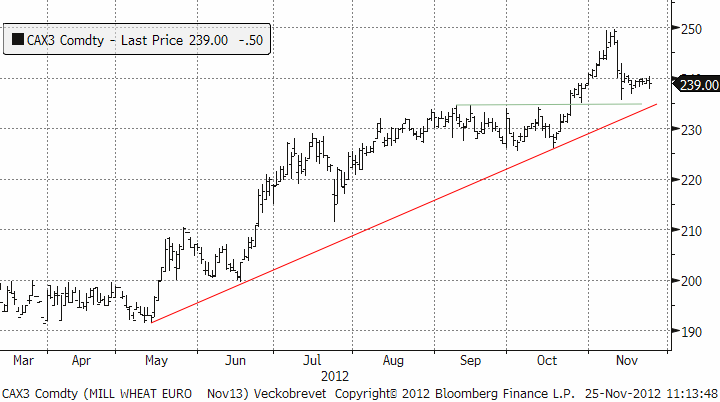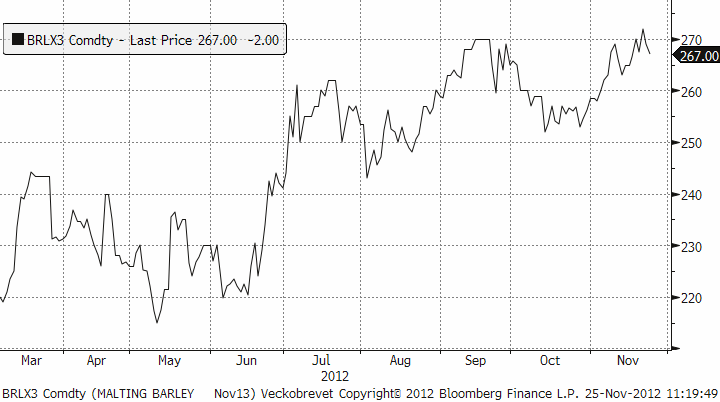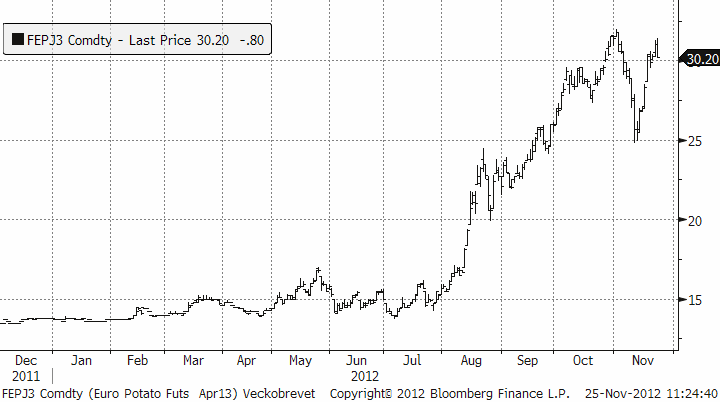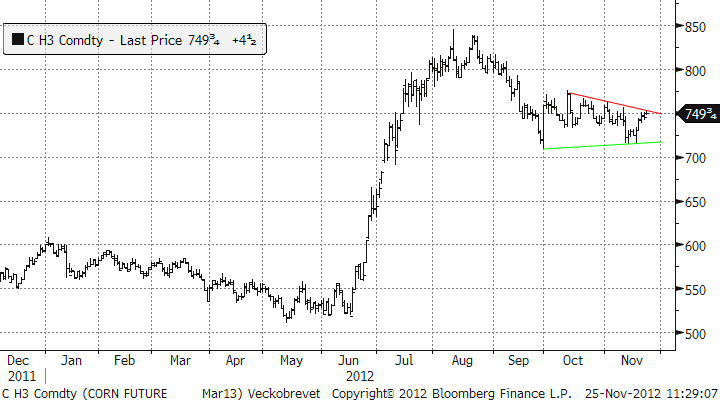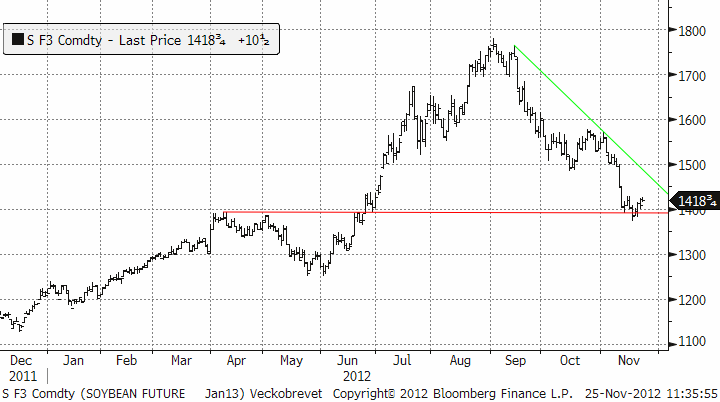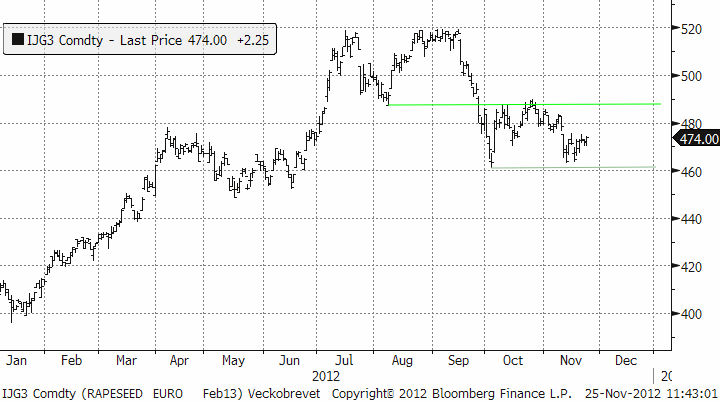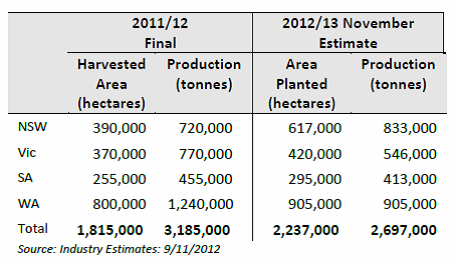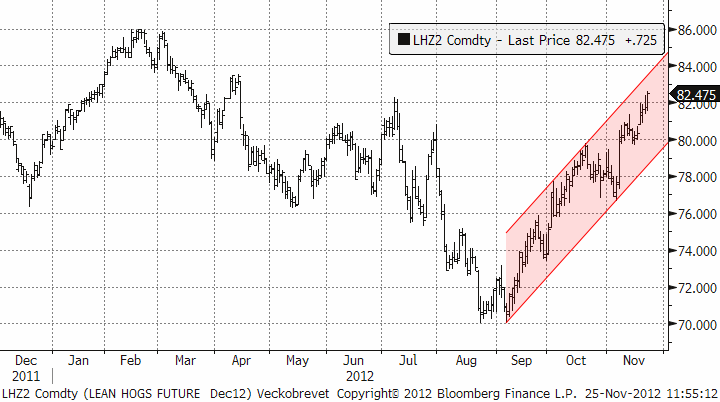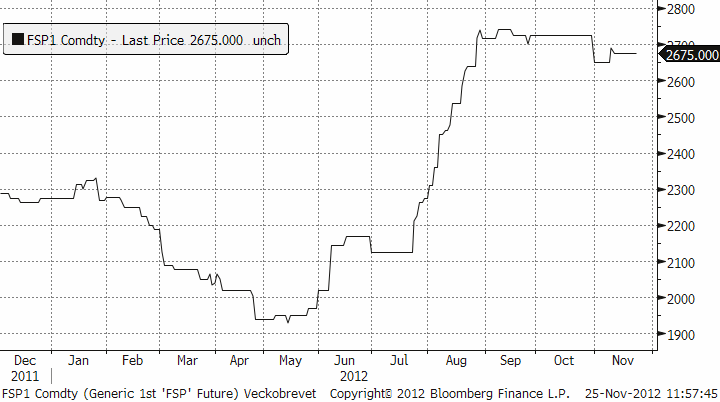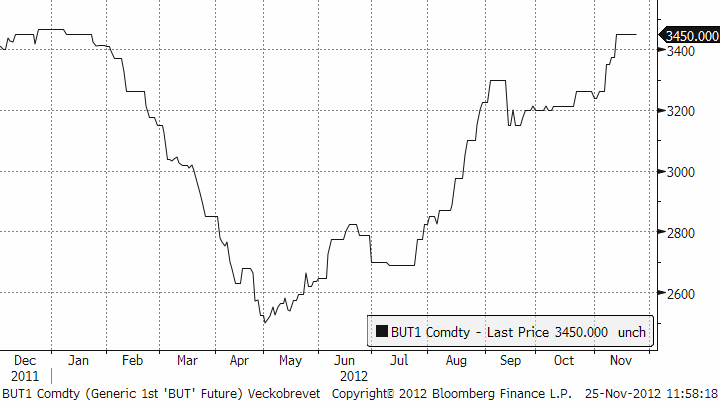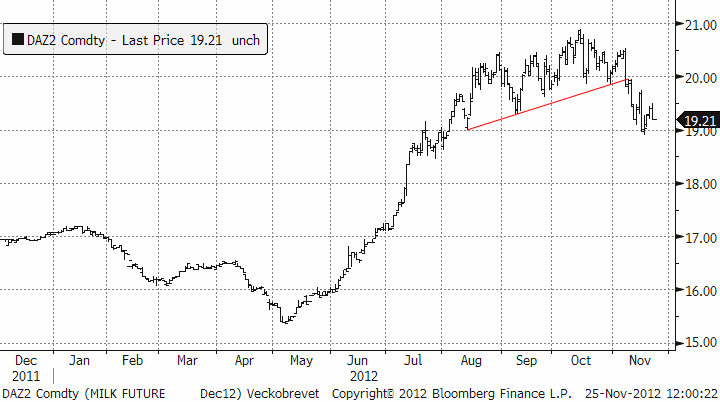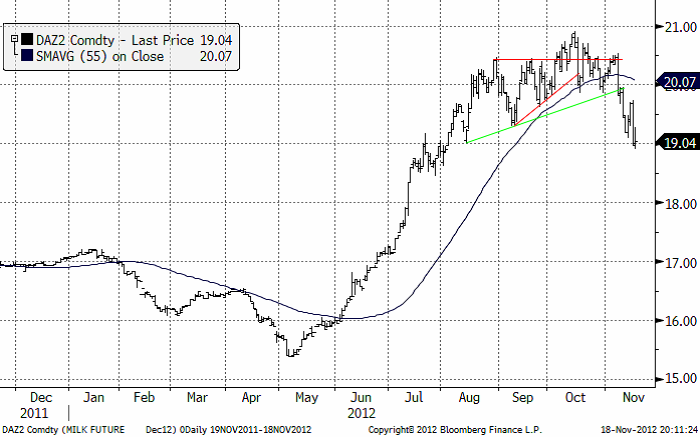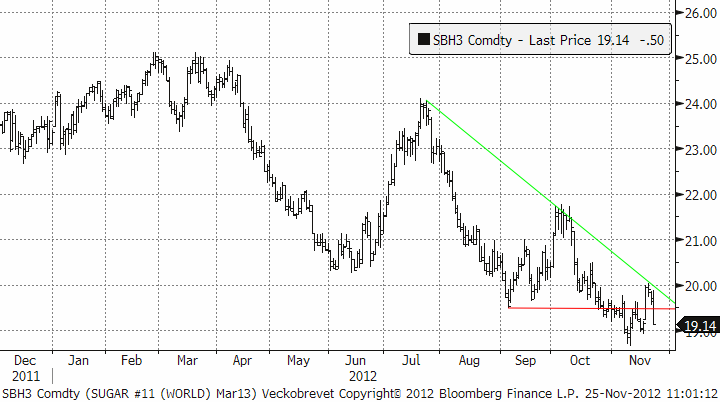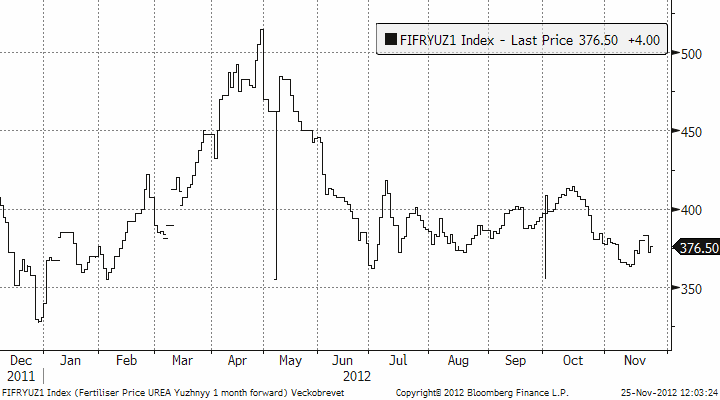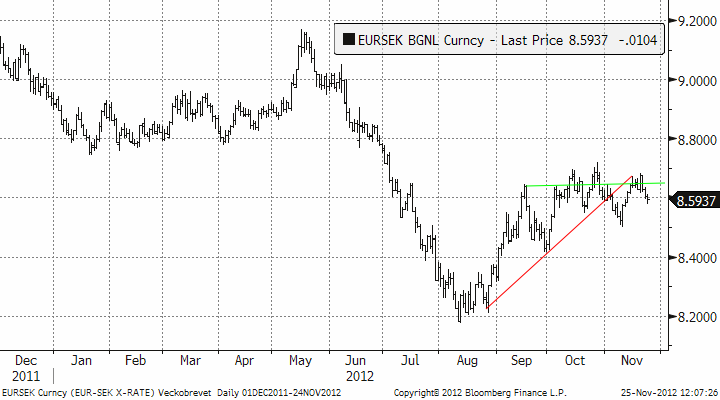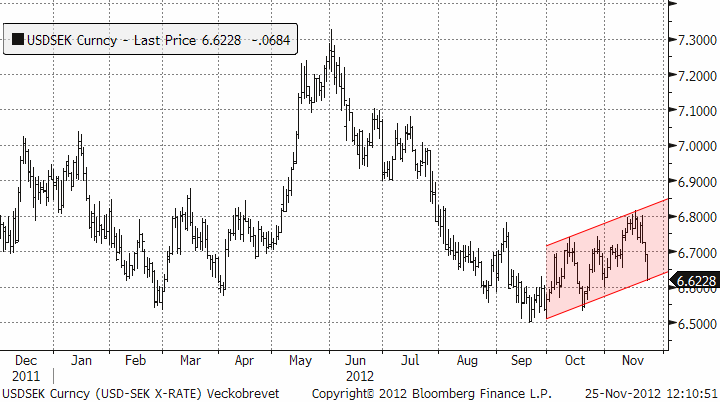Analys
SEB Jordbruksprodukter, 26 november 2012
 Veckan har varit relativt lugn på marknaden för jordbruksprodukter inför Thanksgiving-helgen i USA, med den amerikanska börsen CBOT stängd under torsdagen och halvdag under fredagen.
Veckan har varit relativt lugn på marknaden för jordbruksprodukter inför Thanksgiving-helgen i USA, med den amerikanska börsen CBOT stängd under torsdagen och halvdag under fredagen.
 De makroekonomiska problemen i Europa, som vi nämnde i förra brevet, blev ännu tydligare efter Moodys beslut att sänka Frankrikes rating från högsta betyg – vilket visar på den ökade oron för Eurozonens näst största ekonomi. Turerna kring utbetalningar till Grekland fortsätter då Eurozonens finansministrar återigen misslyckats med att komma överens, USA brottas med det finanspolitiska stupet (fiscal cliff) och spänningarna i Mellanöstern ökar. SEB fortsätter, att som första bank i världen, erbjuda sina kunder att prissäkra ett börsbaserat mjölkpris i kronor per kilo, i poster om 10,000 kg.
De makroekonomiska problemen i Europa, som vi nämnde i förra brevet, blev ännu tydligare efter Moodys beslut att sänka Frankrikes rating från högsta betyg – vilket visar på den ökade oron för Eurozonens näst största ekonomi. Turerna kring utbetalningar till Grekland fortsätter då Eurozonens finansministrar återigen misslyckats med att komma överens, USA brottas med det finanspolitiska stupet (fiscal cliff) och spänningarna i Mellanöstern ökar. SEB fortsätter, att som första bank i världen, erbjuda sina kunder att prissäkra ett börsbaserat mjölkpris i kronor per kilo, i poster om 10,000 kg.
Odlingsväder
Väderförhållandena är fortfarande ett problem i USA och i södra Ryssland som båda lider av underskott vad gäller nederbörd. I Argentina fortsätter sådden att försenas av alltför mycket nederbörd. I Brasilien lider de södra delarna av torka medan andra stora produktionsområden, t.ex Mato Grosso, gynnas av goda väderförhållanden. U.S. Climate Prediction Center uppskattar att torkan i USA, som bl.a påverkar tillståndet för det amerikanska höstvetet nu, kommer att fortsätta långt in i februari.
Den senaste rapporten från Australia Bureau of Meteorology visar att ENSO ligger kvar på en neutral nivå och att det nuvarande neutrala mönstret sannolikt kommer att bestå åtminstone fram till slutet av året.
Även om temperaturerna i Stilla havet ligger under El Niño nivåer, så är de fortfarande över genomsnittet. Southern Oscillation Index (SOI) har hållit sig inom neutrala värden under de senaste två veckorna, och den senaste noteringen ligger nu på +5.1.
Under oktober månad har ihållande regn över Storbritannien och norra Frankrike försenat skörden och hämmat sådden av höstgrödor. Enligt FranceAgrimer var sådden av vete (mjukt) avklarad till 88% per den 12 nov, att jämföra med 98% vid denna tid året innan. Även Spanien och Italien har fått mycket nederbörd, som dels har varit behövligt för att återställa markfuktigheten, men som även har orsakat stora översvämningar – framförallt i norra Italien. Även Sverige har påverkats av regnet, med en minskad höstsådd i framförallt Halland och Mellansverige.
Vete
Nedan ser vi kursdiagrammet för marskontraktet på Matif. Priset har fortsatt sidledes under veckan. Den tekniska analysen kvarstår från förra veckan. ”Priset har rekylerat ner till ett smalt område mellan 265 och 270 euro per ton – motståndslinje ovanför och stöd precis under.
Vi tror att priset kommer att stiga i mars-kontraktet, snarare än falla. Till stöd för detta tar vi novemberkontraktet 2013, som vi ser i kursdiagrammet nedan. Där finns ingen tydlig motståndsnivå på uppsidan, däremot ett starkt stöd som ligger på 235 euro. Vi ser att rekylen från 250 euro har hejdats av stödet. Efter sedvanlig ”sidledes” rörelse för att ta kraften av rekylen, tror vi det är sannolikt att priset gör ett nytt försök uppåt.”
Måndagens Crop Progress från USDA visar att höstvetets uppkomst i de 18 stater som rapporterar ligger på 84%, vilket i stort sett är i linje med det femåriga genomsnittet på 86% vid denna tid. Det torra vädret kvarstår och tillståndet för USA’s höstvete fortsätter att försämras, där endast 34% är klassat som ”good/excellent” nu, vilket är 2% lägre än förra veckan och betydligt lägre än förra årets 50% vid denna tid. Grödor klassade som ”very poor/poor” har ökat med 2% sedan förra veckan och i South Dakota tillhörde 60% denna kategori. Det dåliga skicket på grödorna gör också att de blir mer sårbara för utvintring och rikligt nederbörd över the Plains kommer att vara avgörande i vår för att förhindrabetydande problem och minskad avkastning.
Spannmålsproduktionen i Marocko 2012 uppskattas till 5.3 mt av FAO, en minskning med 38% jämfört med förra årets exceptionella skörd och 23% under det femåriga genomsnittet. Sen sådd av grödor, köldperioder i början av året och därefter torka har bidragit till nedgången i produktionen. Produktionen av vete 2012 förväntas minska från 6.02 mt till 3.87 mt. Importen av spannmål förväntas därmed att öka med 35% under 2012/13 till rekordhöga 8.4 mt, varav 5.2 mt vete. Sådden av höstgrödor (framförallt vete och korn) pågår nu för fullt, och trots att ansenliga mängder nederbörd har saktat ned fältaktiviteten så har markfuktigheten förbättrats avsevärt och därmed gett möjlighet till en tidigare sådd.
Det ryska jordbruksministeriet har höjt sin prognos för landets export av spannmål 2012/13 (juli-juni) från 10-11 mt till 15.5 mt, med hänvisning till att 11 mt – inklusive 8.5 mt vete – redan har exporterats, och utan några avsikter att införa restriktioner. Om exporten skulle komma att uppgå till 15.5 mt eller mer uppskattas ingående lager 2013/14 att hamna på kritiska nivåer (6 mt). Prognosen för sådd av höstgrödor justeras ned till 15.9 miljoner hektar från tidigare 16.82 milj/ha på grund av ogynnsamt väder, Rysslands Grain Union uppskattar exporten av vete till 9.5-10 mt, vilket är i linje med USDA’s estimat på 10 mt i senaste WASDE-rapporten.
Frågorna runt ett eventuellt införande av Ukrainas exportstopp på vete kvarstår.
Tidigare i veckan sa Egyptens GASC att de nästa år kommer att ta bort Ukraina från listan över leverantörer av vete, eftersom Ukraina har planer på att stoppa exporten från den 1 december 2012 – något som GASC ska ha fått en officiell bekräftelse på. Från Ukrainas ambassad i Kairo skickades då en formell begäran till GASC om att kvarstå på listan över leverantörer givet att det finns vete tillgängligt för export och från Egyptens sida säger man nu att Ukraina kommer att stå kvar på listan så länge som kontrakterade kvantiteter kommer att levereras även om ett exportförbud införs.
I allt detta så fortsätter Ukraina att säga att ett exportstopp inte är aktuellt. Så här långt har Ukraina exporterat 10.72 mt spannmål, varav 5.17 mt vete. Årets skörd i Ukraina är nu klar, med en veteproduktion på 15.0 mt, vilket är något lägre än USDA’s nuvarande estimat på 15.5 mt. Irak har varit aktiva i marknaden och köpte 350,000 ton vete från Australien (200,000 t), Kanada (100,000 t) och Ryssland (50,000 t). Amerikanskt vete fanns med bland anbuden men ligger fortfarande för högt i pris.
Sverige
Preliminära uppgifter på riksnivå från Jordbruksverket för 2012 visar att Sveriges totalskörd av spannmål beräknas uppgå till 5.1 mt, en ökning med 10% från 2011 och 4% högre än genomsnittet för de senaste fem åren. Totalskörden av höstvete beräknas preliminärt att uppgå till närmare 2 mt (38% av den totala spannmålsskörden) och trots att höstvetearealen minskade jämfört med förra året så är totalskörden i nivå med förra årets skörd eftersom hektarskörden ökade med drygt 20% jämfört med 2011.
Maltkorn
November 2013-kontraktet har testat motståndet vid 270, men föll tillbaka. 270 verkar vara ett starkt motstånd.
Potatis
Potatispriset som tidigare fann stöd på 25 euro per deciton, har fortsatt att stiga och noterar nu ett motstånd vid 31 eur.
Majs
Majspriset (mars 2013) har vid två tillfällen nu hållit stödet 709 cent per ton, och testar nu istället motståndsnivån kring 750. Ett genombrott av den nivån kan innebära ytterligare test för högre nivåer, och om det sker bör man överväga att minska korta exponeringar, och vänta in nya säljlägen.
Safras e Mercados senaste rapport visar att sådden av majs i Brasilien nu är avklarad till 81% och produktionen av majs 2012/13 förväntas uppgå till 68.969 mt, jämfört med 2011/12 års produktion på 72.336 mt.
Sådden av majs i Argentina går fortsatt framåt om än långsamt. 55% av sådden är nu avklarad, att jämföra med förra årets 68% vid den här tiden. Cordonnier uppskattar produktionen 2012/13 i Brasilien och Argentina till 72 mt respektive 22.5 mt, jämfört med USDA’s prognos på 70 mt respektive 28 mt.
I Ukraina är skörden av majs avklarad till 89% och den totala skörden beräknas uppgå till ca 20 mt, strax under USDA’s estimat på 21 mt. Majs kommer att bli den stora exportvaran från och med nu, och exporten uppskattas till 12 mt.
Sojabönor
Efter att ha konsoliderat i veckan som gick, slutade veckan med en uppåtrekyl i januarikontraktet. Stängningen signalerar en fortsatt rekyl uppåt som bör möta starkt motstånd vid motståndslinjen (se nedan). Vi fortsätter att rekommendera en kort position (såld) i sojabönor.
Enligt Safras e Mercado är nu sådden av sojabönor i Brasilien avklarad till 66% jämfört med 54% förra veckan. Produktionen för 2012/13 beräknas öka med nästan 22% till 82.47 mt, från 2011/12 års 67.76 mt.
Sådden av sojabönor i Argentina avklarad till 31% jämfört med 18% förra veckan. Produktionen estimeras till 57.42 mt, en ökning från 2011/12 års 41.0 mt.
Den totala produktionen i Sydamerika 2012/13 uppskattas till 152.98 mt, upp från 2011/12 års 117.036 mt, med följande prognoser för övriga länder (med 2011/12 inom parentes):
Paraguay 8.64 mt (4.30 mt), Bolivia 2.56 mt (2.38 mt) och Uruguay 1.9 mt (1.6 mt)
Cordonnier uppskattar produktionen 2012/13 i Brasilien och Argentina till 80 mt respektive 55.0 mt.
Oil World justerar ned sin prognos för produktionen av sojabönor 2013 i Argentina och Brasilien med totalt 3 mt, till följd av ogynnsamt väder som har påverkat sådden i de bägge länderna – torka i delar av Brasilien och alltför mycket regn i delar av Argentina. Estimatet för Argentina uppgår nu till 54 mt, mot det tidigare estimatet för en månad sedan på 56 mt, vilket dock är betydligt högre än de 40.5 mt som landet skördade i början av 2012. Prognosen för Brasiliens produktion uppgår nu till 81 mt, en nedjustering från oktobers 81 mt, men fortfarande en bra bit över skörden i början av 2012 på 66.8 mt.
Raps
Rapspriset (februari 2013) handlas i ett brett intervall 460-490 och befinner sig i mitten. Marknaden strävar mot stödnivån och vi rekommenderar fortfarande en kort position. Får vi ett brott nedåt av 460- nivån, bör man sälja ännu mer.
AOF (Australian Oilseeds Federation) säger att utsikterna är goda för ytterligare en stor canola skörd under 2012 nu när skörden drar igång, och uppskattar produktionen av canola 2012/13 till 2.697 mt, jämfört med 3.185 mt 2011/12. Men med en prognos på nästan 2.7 mt så kommer det att bli den näst största rapsskörden, endast överträffad av skörden året innan. Storleken på skörden kommer att påverkas mer av hektar än avkastning, som förväntas uppgå till 2.37 miljoner hektar sådd areal, en ökning från det tidigare rekordet med 23%, medan avkastningen estimeras till ett genomsnitt på 1.2 t/ha – vilket är lägre än det femåriga genomsnittet på 1.5 t/ha.
Preliminära uppgifter på riksnivå från Jordbruksverket för 2012 visar att Sveriges totalskörd av raps och rybs uppskattas till 325 400 ton, vilket är en ökning med 30% jämfört med förra året och den högsta totalskörden på 19 år. Hektarskörden beräknas till 3.75 t/ha, vilket är det högsta som hittills redovisats på riksnivå. Odlingen av höstraps ökade med 10% och avkastningen med 22% jämfört med 2011. Arealen för vårraps ökade med 23% medan hektarskörden nästan var i nivå med föregående års skördeutfall per hektar.
Gris
Grispriset (Dec 12) har fortsatt upp under den senaste veckan. Priset ligger på höga nivåer, nästan lika höga som i somras och uppgången bör ta slut på de här nivåerna. Gris terminer har en säsongs tendens att stiga efter Thanksgiving helgen, men den trenden borde vara begränsad nu i och med de redan höga nivåerna.
Mjölk
Från EUREX priser på smör och SMP kan vi utläsa att priset för ett kilo mjölk(råvara) nu ligger på 3.55 kr per kilo. Anledning till att priset har sjunkit sedan förra veckans 3.58 kr, trots att priset på mjölpulver och smör är oförändrade, är att den svenska kronan har stärkts mot euron. Priset på mjölkpulver i Nordeuropa är oförändrat sedan förra veckan (2675 euro per ton ).
Nedan ser vi priset på smör, som också är oförändrat sedan förra veckans notering på 3450 euro per ton.
Det börsbaserade priset i svenska kronor beräknas med formeln:
där
BUT = priset på smör i euro per ton
SMP = priset på skummjölkspulver i euro per ton
FX = växelkursen för EURSEK.
Precis som vi skrev i förra veckans brev så fann priset på Klass 3 mjölk, på den amerikanska börsen CME i Chicago, tekniskt stöd på 19 cent per pund och rekylerade uppåt därifrån. Trenden är dock nedåtriktad och en rekyl uppåt tycker vi ska ses som ett säljtillfälle.
Socker
Priset på socker (mars 2013) befinner sig i en stark baissemarknad. I veckan som gått rekylerade priset upp ännu en gång strax över motståndsnivån och vände sedan ner igen. Det mest sannolika tycker vi är att priset faller och söker en ny bottennotering.
Gödsel
Januari kontraktet för Yuzhnyy som fann en stödnivå på 365 $ / ton i förra veckan har fortsatt uppåt denna vecka och noteras nu på 376.50 $ / ton.
EURSEK
EURSEK föll i veckan som gick, precis som vi förutspådde i förra veckans veckobrev. Vi tror fortsättningsvis på en ”sidledes” eller fallande kurs.
USDSEK
Genombrottet av USDSEK som vi skrev i förra veckan fick inte den väntade följdrörelsen. Kronan är stark och när dollarn försvagades i fredags blev fallet stort för usdsek. Stödet kommer nu in kring 6,60.
[box]SEB Veckobrev Jordbruksprodukter är producerat av SEB Merchant Banking och publiceras i samarbete och med tillstånd på Råvarumarknaden.se[/box]
Disclaimer
The information in this document has been compiled by SEB Merchant Banking, a division within Skandinaviska Enskilda Banken AB (publ) (“SEB”).
Opinions contained in this report represent the bank’s present opinion only and are subject to change without notice. All information contained in this report has been compiled in good faith from sources believed to be reliable. However, no representation or warranty, expressed or implied, is made with respect to the completeness or accuracy of its contents and the information is not to be relied upon as authoritative. Anyone considering taking actions based upon the content of this document is urged to base his or her investment decisions upon such investigations as he or she deems necessary. This document is being provided as information only, and no specific actions are being solicited as a result of it; to the extent permitted by law, no liability whatsoever is accepted for any direct or consequential loss arising from use of this document or its contents.
About SEB
SEB is a public company incorporated in Stockholm, Sweden, with limited liability. It is a participant at major Nordic and other European Regulated Markets and Multilateral Trading Facilities (as well as some non-European equivalent markets) for trading in financial instruments, such as markets operated by NASDAQ OMX, NYSE Euronext, London Stock Exchange, Deutsche Börse, Swiss Exchanges, Turquoise and Chi-X. SEB is authorized and regulated by Finansinspektionen in Sweden; it is authorized and subject to limited regulation by the Financial Services Authority for the conduct of designated investment business in the UK, and is subject to the provisions of relevant regulators in all other jurisdictions where SEB conducts operations. SEB Merchant Banking. All rights reserved.
Analys
Crude oil soon coming to a port near you

Rebounding along with most markets. But concerns over solidity of Gaza peace may also contribute. Brent crude fell 0.8% yesterday to $61.91/b and its lowest close since May this year. This morning it is bouncing up 0.9% to $62.5/b along with a softer USD amid positive sentiment with both equities and industrial metals moving higher. Concerns that the peace in Gaza may be less solid than what one might hope for also yields some support to Brent. Bets on tech stocks are rebounding, defying fears of trade war. Money moving back into markets. Gold continues upwards its strong trend and a softer dollar helps it higher today as well.

US crude & products probably rose 5.6 mb last week (API) versus a normal seasonal decline of 2.4 mb. The US API last night partial and thus indicative data for US oil inventories. Their data indicates that US crude stocks rose 7.4 mb last week, gasoline stocks rose 3.0 mb while Distillate stocks fell 4.8 mb. Altogether an increase in commercial crude and product stocks of 5.6 mb. Commercial US crude and product stocks normally decline by 2.4 mb this time of year. So seasonally adjusted the US inventories rose 8 mb last week according to the indicative numbers by the API. That is a lot. Also, the counter seasonal trend of rising stocks versus normally declining stocks this time of year looks on a solid pace of continuation. If the API is correct then total US crude and product stocks would stand 41 mb higher than one year ago and 6 mb higher than the 2015-19 average. And if we combine this with our knowledge of a sharp increase in production and exports by OPEC(+) and a large increase in oil at sea, then the current trend in US oil inventories looks set to continue. So higher stocks and lower crude oil prices until OPEC(+) switch to cuts. Actual US oil inventory data today at 18:00 CET.
US commercial crude and product stocks rising to 1293 mb in week 41 if last nights indicative numbers from API are correct.

Crude oil soon coming to a port near you. OPEC has lifted production sharply higher this autumn. At the same time demand for oil in the Middle-East has fallen as we have moved out of summer heat and crude oil burn for power for air-conditioning. The Middle-East oil producers have thus been able to lift exports higher on both accounts. Crude oil and condensates on water has shot up by 177 mb since mid-August. This oil is now on its way to ports around the world. And when they arrive, it will likely help to lift stocks onshore higher. That is probably when we will lose the last bit of front-end backwardation the the crude oil curves. That will help to drive the front-month Brent crude oil price down to the $60/b line and revisit the high $50ies/b. Then the eyes will be all back on OPEC+ when they meet in early November and then again in early December.
Crude oil and condensates at sea have moved straight up by 177 mb since mid-August as OPEC(+) has produced more, consumed less and exported more.

Analys
The Mid-East anchor dragging crude oil lower

When it starts to move lower it moves rather quickly. Gaza, China, IEA. Brent crude is down 2.1% today to $62/b after having traded as high as $66.58/b last Thursday and above $70/b in late September. The sell-off follows the truce/peace in Gaze, a flareup in US-China trade and yet another bearish oil outlook from the IEA.

A lasting peace in Gaze could drive crude oil at sea to onshore stocks. A lasting peace in Gaza would probably calm down the Houthis and thus allow more normal shipments of crude oil to sail through the Suez Canal, the Red Sea and out through the Bab-el-Mandeb Strait. Crude oil at sea has risen from 48 mb in April to now 91 mb versus a pre-Covid normal of about 50-60 mb. The rise to 91 mb is probably the result of crude sailing around Africa to be shot to pieces by the Houthis. If sailings were to normalize through the Suez Canal, then it could free up some 40 mb in transit at sea moving onshore into stocks.
The US-China trade conflict is of course bearish for demand if it continues.
Bearish IEA yet again. Getting closer to 2026. Credibility rises. We expect OPEC to cut end of 2025. The bearish monthly report from the IEA is what it is, but the closer we get to 2026, the more likely the IEA is of being ball-park right in its outlook. In its monthly report today the IEA estimates that the need for crude oil from OPEC in 2026 will be 25.4 mb/d versus production by the group in September of 29.1 mb/d. The group thus needs to do some serious cutting at the end of 2025 if it wants to keep the market balanced and avoid inventories from skyrocketing. Given that IEA is correct that is. We do however expect OPEC to implement cuts to avoid a large increase in inventories in Q1-26. The group will probably revert to cuts either at its early December meeting when they discuss production for January or in early January when they discuss production for February. The oil price will likely head yet lower until the group reverts to cuts.
Dubai: The Mid-East anchor dragging crude oil lower. Surplus emerging in Mid-East pricing. Crude oil prices held surprisingly strong all through the summer. A sign and a key source of that strength came from the strength in the front-end backwardation of the Dubai crude oil curve. It held out strong from mid-June and all until late September with an average 1-3mth time-spread premium of $1.8/b from mid-June to end of September. The 1-3mth time-spreads for Brent and WTI however were in steady deterioration from late June while their flat prices probably were held up by the strength coming from the Persian Gulf. Then in late September the strength in the Dubai curve suddenly collapsed. Since the start of October it has been weaker than both the Brent and the WTI curves. The Dubai 1-3mth time-spread now only stands at $0.25/b. The Middle East is now exporting more as it is producing more and also consuming less following elevated summer crude burn for power (Aircon) etc.
The only bear-element missing is a sudden and solid rise in OECD stocks. The only thing that is missing for the bear-case everyone have been waiting for is a solid, visible rise in OECD stocks in general and US oil stocks specifically. So watch out for US API indications tomorrow and official US oil inventories on Thursday.
No sign of any kind of fire-sale of oil from Saudi Arabia yet. To what we can see, Saudi Arabia is not at all struggling to sell its oil. It only lowered its Official Selling Prices (OSPs) to Asia marginally for November. A surplus market + Saudi determination to sell its oil to the market would normally lead to a sharp lowering of Saudi OSPs to Asia. Not yet at least and not for November.
The 5yr contract close to fixed at $68/b. Of importance with respect to how far down oil can/will go. When the oil market moves into a surplus then the spot price starts to trade in a large discount to the 5yr contract. Typically $10-15/b below the 5yr contract on average in bear-years (2009, 2015, 2016, 2020). But the 5yr contract is usually pulled lower as well thus making this approach a moving target. But the 5yr contract price has now been rock solidly been pegged to $68/b since 2022. And in the 2022 bull-year (Brent spot average $99/b), the 5yr contract only went to $72/b on average. If we assume that the same goes for the downside and that 2026 is a bear-year then the 5yr goes to $64/b while the spot is trading at a $10-15/b discount to that. That would imply an average spot price next year of $49-54/b. But that is if OPEC doesn’t revert to cuts and instead keeps production flowing. We think OPEC(+) will trim/cut production as needed into 2026 to prevent a huge build-up in global oil stocks and a crash in prices. But for now we are still heading lower. Into the $50ies/b.
Analys
More weakness and lower price levels ahead, but the world won’t drown in oil in 2026

Some rebound but not much. Brent crude rebounded 1.5% yesterday to $65.47/b. This morning it is inching 0.2% up to $65.6/b. The lowest close last week was on Thursday at $64.11/b.

The curve structure is almost as week as it was before the weekend. The rebound we now have gotten post the message from OPEC+ over the weekend is to a large degree a rebound along the curve rather than much strengthening at the front-end of the curve. That part of the curve structure is almost as weak as it was last Thursday.
We are still on a weakening path. The message from OPEC+ over the weekend was we are still on a weakening path with rising supply from the group. It is just not as rapidly weakening as was feared ahead of the weekend when a quota hike of 500 kb/d/mth for November was discussed.
The Brent curve is on its way to full contango with Brent dipping into the $50ies/b. Thus the ongoing weakening we have had in the crude curve since the start of the year, and especially since early June, will continue until the Brent crude oil forward curve is in full contango along with visibly rising US and OECD oil inventories. The front-month Brent contract will then flip down towards the $60/b-line and below into the $50ies/b.
At what point will OPEC+ turn to cuts? The big question then becomes: When will OPEC+ turn around to make some cuts? At what (price) point will they choose to stabilize the market? Because for sure they will. Higher oil inventories, some more shedding of drilling rigs in US shale and Brent into the 50ies somewhere is probably where the group will step in.
There is nothing we have seen from the group so far which indicates that they will close their eyes, let the world drown in oil and the oil price crash to $40/b or below.
The message from OPEC+ is also about balance and stability. The world won’t drown in oil in 2026. The message from the group as far as we manage to interpret it is twofold: 1) Taking back market share which requires a lower price for non-OPEC+ to back off a bit, and 2) Oil market stability and balance. It is not just about 1. Thus fretting about how we are all going to drown in oil in 2026 is totally off the mark by just focusing on point 1.
When to buy cal 2026? Before Christmas when Brent hits $55/b and before OPEC+ holds its last meeting of the year which is likely to be in early December.
Brent crude oil prices have rebounded a bit along the forward curve. Not much strengthening in the structure of the curve. The front-end backwardation is not much stronger today than on its weakest level so far this year which was on Thursday last week.

The front-end backwardation fell to its weakest level so far this year on Thursday last week. A slight pickup yesterday and today, but still very close to the weakest year to date. More oil from OPEC+ in the coming months and softer demand and rising inventories. We are heading for yet softer levels.

-

 Nyheter3 veckor sedan
Nyheter3 veckor sedanOPEC+ missar produktionsmål, stöder oljepriserna
-

 Nyheter3 veckor sedan
Nyheter3 veckor sedanEtt samtal om guld, olja, fjärrvärme och förnybar energi
-

 Nyheter2 veckor sedan
Nyheter2 veckor sedanGuld nära 4000 USD och silver 50 USD, därför kan de fortsätta stiga
-

 Analys3 veckor sedan
Analys3 veckor sedanAre Ukraine’s attacks on Russian energy infrastructure working?
-

 Nyheter1 vecka sedan
Nyheter1 vecka sedanGoldman Sachs höjer prognosen för guld, tror priset når 4900 USD
-

 Nyheter2 veckor sedan
Nyheter2 veckor sedanBlykalla och amerikanska Oklo inleder ett samarbete
-

 Nyheter4 veckor sedan
Nyheter4 veckor sedanGuldpriset uppe på nya höjder, nu 3750 USD
-

 Nyheter2 veckor sedan
Nyheter2 veckor sedanEtt samtal om guld, olja, koppar och stål


